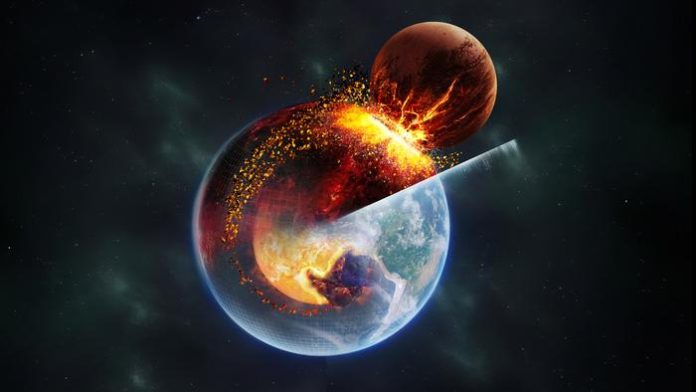An interdisciplinary international research team has recently made a groundbreaking discovery, shedding new light on Earth’s history and the formation of our solar system. The study, led by Prof. DENG Hongping of the Shanghai Astronomical Observatory (SHAO) of the Chinese Academy of Sciences, suggests that a massive anomaly deep within Earth’s interior may be remnants of a collision that occurred approximately 4.5 billion years ago, leading to the formation of the Moon. This discovery challenges long-standing theories about the Earth’s internal structure and has far-reaching implications for our understanding of planetary evolution.
The widely accepted theory of Moon formation posits that a massive collision, known as the “giant impact,” took place during the late stages of Earth’s growth, involving primordial Earth (Gaia) and a Mars-sized proto-planet named Theia. It was believed that the Moon formed from the debris generated by this cataclysmic event. However, the compositions of the Earth and the Moon appeared to be remarkably similar, contrary to what was expected given their different origins. This discrepancy presented a longstanding enigma for scientists.
In a quest to refine the theory of lunar formation, Prof. DENG embarked on research in 2017, developing a novel computational fluid dynamics method known as Meshless Finite Mass (MFM). Through numerous simulations of the giant impact, the research team discovered that the Earth’s mantle exhibited stratification after the collision, with the upper mantle resembling a magma ocean created through the mixing of materials from Gaia and Theia, while the lower mantle remained solid and retained Gaian material composition.
The implications of this discovery are profound. It challenges the traditional notion that the giant impact led to the homogenization of the early Earth. Instead, the Moon-forming giant impact seems to have initiated the early mantle’s heterogeneity, marking the starting point for Earth’s geological evolution over 4.5 billion years.
Furthermore, the research unveiled the origins of two mysterious regions within Earth’s mantle called Large Low Velocity Provinces (LLVPs), which have long puzzled scientists. These regions, located beneath the African and Pacific tectonic plates, exhibit reduced seismic wave velocities when passed through. The team led by Dr. YUAN Qian from the California Institute of Technology proposed that LLVPs could have evolved from a small amount of Theian material that entered Gaia’s lower mantle during the giant impact.
Through in-depth analysis and precision simulations, the research team determined that a significant amount of Theian mantle material, approximately two percent of Earth’s mass, entered the lower mantle of Gaia. This material, enriched with iron, sank to the bottom of the mantle, forming the LLVP regions, which have remained stable over billions of years.
The presence of heterogeneity in the deep mantle, whether in the mid-mantle reflectors or the LLVPs at the base, challenges the idea of Earth’s interior as a uniform system. This discovery suggests that even small amounts of deep-seated heterogeneity can be brought to the surface by mantle plumes, such as those responsible for the formation of geological features like Hawaii and Iceland.
The findings from this research pave the way for a deeper understanding of Earth’s initial state and the formation of neighboring planets through the precise analysis of a wider range of rock samples, more refined giant impact models, and Earth evolution models. Ultimately, this work may offer insight into the formation and habitability of exoplanets beyond our solar system.
This groundbreaking research was published as a featured cover article in the journal Nature on November 2, 2023, and marks a significant milestone in our quest to unravel the mysteries of our planet’s history and its place in the cosmos.















